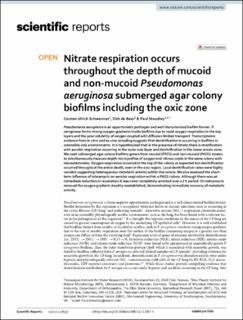Nitrate respiration occurs throughout the depth of mucoid and non-mucoid Pseudomonas aeruginosa submerged agar colony biofilms including the oxic zone
Peer reviewed, Journal article
Published version
Permanent lenke
https://hdl.handle.net/11250/3016940Utgivelsesdato
2022Metadata
Vis full innførselSamlinger
- Publikasjoner fra Cristin - NIVA [2160]
- Scientific publications [1172]
Sammendrag
Pseudomonas aeruginosa is an opportunistic pathogen and well characterized biofilm former. P. aeruginosa forms strong oxygen gradients inside biofilms due to rapid oxygen respiration in the top layers and the poor solubility of oxygen coupled with diffusion limited transport. Transcriptomic evidence from in vitro and ex vivo sampling suggests that denitrification is occurring in biofilms in ostensibly oxic environments. It is hypothesized that in the presence of nitrate there is stratification with aerobic respiration occurring in the outer oxic layer and denitrification in the lower anoxic zone. We used submerged agar colony biofilms grown from mucoid (FRD1) and non-mucoid (PAO1) strains to simultaneously measure depth microprofiles of oxygen and nitrous oxide in the same colony with microelectrodes. Oxygen respiration occurred at the top of the colony as expected but denitrification occurred throughout the entire depth, even in the oxic region. Local denitrification rates were highly variable suggesting heterogenous metabolic activity within the colony. We also assessed the short-term influence of tobramycin on aerobic respiration within a PAO1 colony. Although there was an immediate reduction in respiration it was never completely arrested over a 2 h period. On tobramycin removal the oxygen gradient steadily reestablished, demonstrating immediate recovery of metabolic activity.

